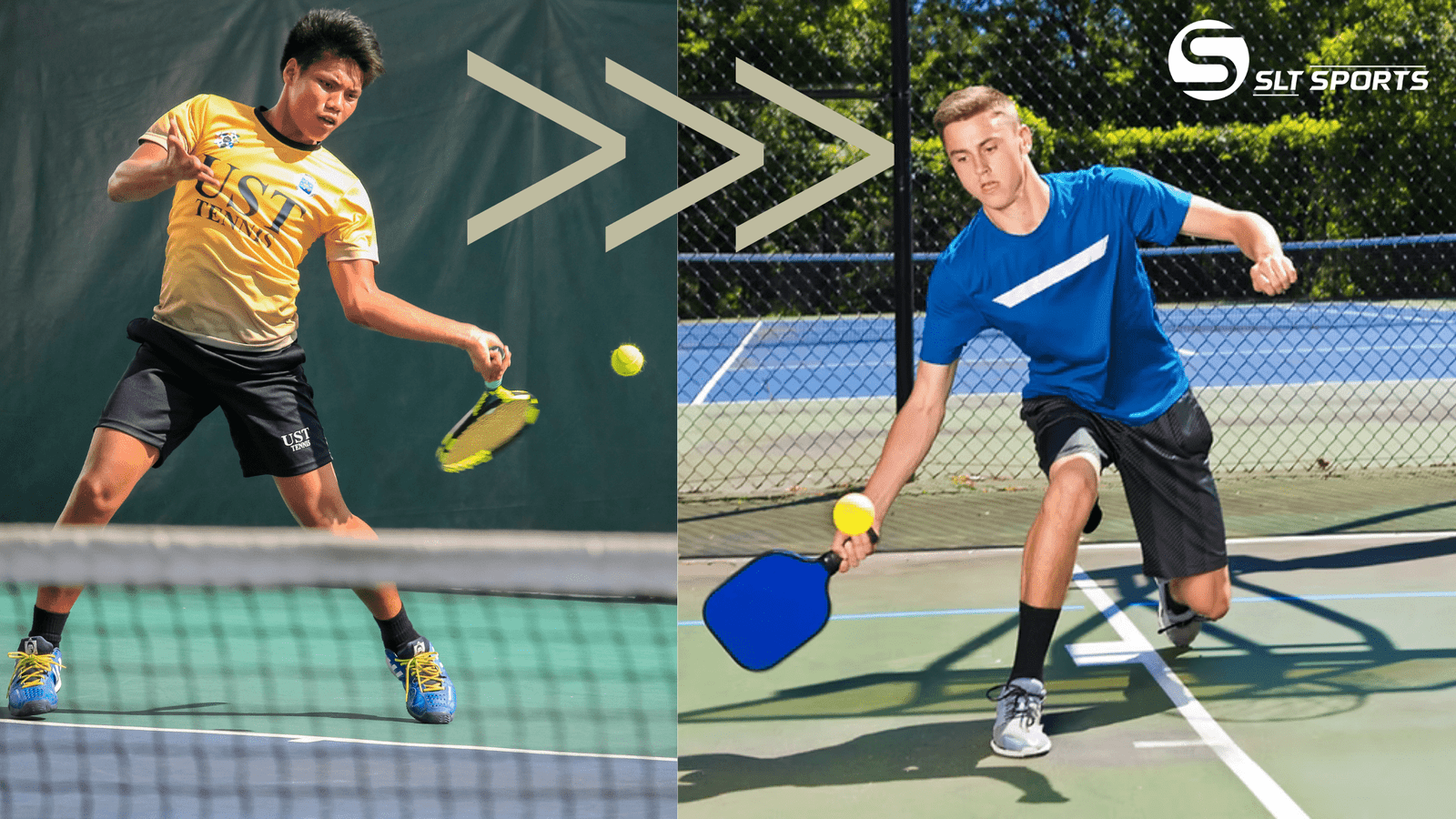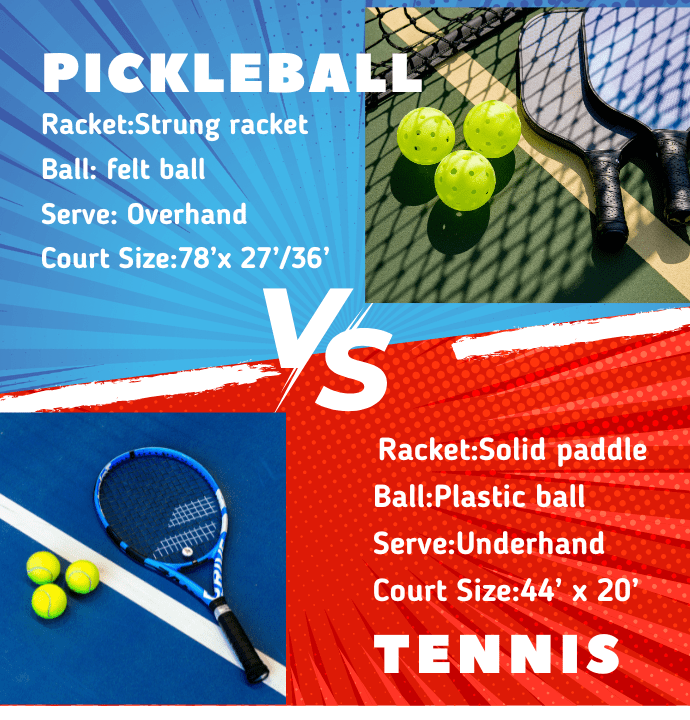
In recent years the sports world has seen a big shift, as more tennis players are switching to pickleball. The casual backyard game has become one of the fastest growing sports in the world. This is more evident than ever in 2025. The attractiveness of pickleball itself is not the only reason for this trend but the court infrastructure, particularly the pickleball court flooring, is also changing. This blog will explore why tennis players are making the switch, with a deep dive into the flooring perspective for those considering court conversion or construction.
But what’s behind this trend? Is it just the rules and the pace of the game or is the infrastructure, particularly court flooring, playing a big role? In this blog we will explore the reasons behind this shift, the key differences between tennis and pickleball courts and the implications for those looking to build or convert courts in 2025.
What’s The Difference: Pickleball Vs Tennis
Tennis and pickleball have some similarities—net based play and court markings—but they are very different in playing style, intensity and player experience. Due to these differences many tennis players are making the switch.
Key Differences: Pickleball vs Tennis
- Court Size and Coverage
- Tennis: A full sized tennis court is 78 feet by 36 feet for doubles play. The size requires tennis players to cover more ground which can be physically demanding especially for older players or those with mobility issues.
- Pickleball: A standard pickleball court is much smaller 20 feet by 44 feet, easier to navigate and suitable for indoor or outdoor play.
- Pace and Style of Play
- Tennis: Long rallies, high speed serves and aggressive lateral movement.
- Pickleball: More about strategic placement, control and finesse. Slower ball, underhand serves and fewer acrobatic movements.
- Learning Curve and Accessibility
- Pickleball is easier to learn and master. Less intimidating and many players feel a quicker sense of progress and enjoyment.
- Demographics and Community
- Pickleball is played in doubles which promotes social interaction. Communities are building around it, tournaments, leagues and social gatherings.This is why pickleball is growing fast and is the go to sport for tennis players who want to play competitive sport without the physical demands of tennis.
Tennis vs Pickleball Court Surface: What’s The Difference?
From a construction standpoint, sports court surface design is key to player experience. Both tennis court flooring and pickleball court flooring may use concrete or asphalt sub-bases but their top layers are very different in composition and function.
Tennis court flooring is built with hard acrylic coatings over the base layer. These surfaces are designed for high speed ball movement, quick footwork and lateral movement. The tennis court surface provides a specific level of grip that suits tennis but may be too harsh for pickleball.
Pickleball court surfaces are designed for comfort and controlled bounce. The pickleball court materials used are tailored to the unique dynamics of the game, better traction without being too aggressive. This reduces the impact on joints especially for older or recreational players.
The top coatings and texturing are customized for each sport even if the structure beneath is the same. To improve player safety and game performance, resurfacing a tennis court with a more suitable top layer is often necessary when converting it to pickleball.
Why Pickleball Court Flooring Is Replacing Tennis Court Surfaces
The rapid growth of pickleball has many sports facility owners and real estate developers rethinking their court offerings. Replacing an old tennis court is often more cost effective and profitable than maintaining them.
Pickleball courts require less maintenance than tennis court flooring because of the smaller surface area and less wear. The gameplay is less intense on the flooring which prolongs the life of the materials used. A single tennis court can be converted into multiple pickleball courts making it more efficient to use space.
With demand for pickleball facilities growing, venues that cater are seeing more bookings, memberships and community engagement. The revenue potential from coaching programs, tournaments and social play is much higher when the space can accommodate more courts and players.
Modern synthetic acrylic pickleball flooring is long term durable and performs. These surfaces are easier to install, cost effective and designed specifically for pickleball players. Facility managers are realizing that investing in the right flooring pays off through lower maintenance and higher user satisfaction.
Pickleball Court Construction Materials: A Closer Look
A high performance pickleball court needs attention to every layer from sub base to top coat. Each layer plays a role in making the court durable, safe and optimal for play.
The base layer is usually asphalt or concrete. This provides a solid foundation for the entire structure. It has to be level and sloped for drainage to prevent water accumulation.
Once the base is ready a bonding agent or primer is applied. This helps the acrylic coatings to adhere properly to the surface. Then an acrylic resurfacer is used to smoothen out minor imperfections and prepare the surface for the color coats.
Textured acrylic color coats are applied in multiple layers. These are mixed with fine silica sand to get the desired grip and bounce control. Finally precise line markings are painted using UV resistant paints for visibility and durability.
All these need to work together to create a court that meets performance standards and withstands India’s climate.
What Are the Best Pickleball Flooring Materials?
Choosing the right pickleball flooring materials is key to long term performance, safety and cost effectiveness. At SLT Sports we recommend flooring systems designed for Indian weather and player requirements.
Synthetic acrylic systems are the most popular choice. These multi layer coatings are applied over a concrete or asphalt base and provide excellent grip, UV resistance and colour retention. They are suitable for outdoor pickleball court surfaces making them versatile and reliable.
Facilities, those who are looking to add comfort and reduce joint stress, cushioned acrylic systems are the way to go. These have a rubberized underlayer that provides extra shock absorption. Such flooring systems are ideal for senior citizens or community sports centers.
Modular interlocking tiles are another option, used for indoor or temporary installations. They are quick to install and portable, but are less common for outdoor use in India due to weather limitations.
Each type of sports flooring material has its own advantages. Our experts work closely with clients to choose the best solution based on location, expected usage and budget.

Cost to Convert Tennis Court to Pickleball Court
One of the most common questions we get is: “What’s the cost to convert a tennis court to pickleball court in 2025?”
Cost depends on several factors. First the condition of the existing tennis court needs to be checked. Minor cracks and surface damage can be repaired easily, but severe issues require a full resurfacing or reconstruction.
The number of pickleball courts you plan to install also plays a role. One tennis court can be divided into 4 pickleball courts depending on spacing, layout and player comfort. The type of flooring chosen for basic acrylic vs cushioned systems also affects the cost.
Additional elements like fencing, lighting, drainage improvements and net systems can add to the cost. But these upgrades often enhance the player experience and increase the value of the facility. In 2025, the pickleball court cost in India ranges from ₹3.5 to ₹5.5 lakh for a basic conversion and ₹6.5 to ₹9 lakh for premium cushioned systems.
Can You Use Tennis Flooring for Pickleball?
Tennis flooring is designed for a different kind of play—high speed rallies, lateral movement and high impact footwork. These don’t match the requirements of pickleball which needs softer bounce, more grip control and better joint protection.
Using a tennis court surface for pickleball may result in poor ball bounce, higher knee strain and overall suboptimal playing experience. It may be okay for casual games but competitive or regular players will benefit much more from surfaces designed for pickleball.
That’s why upgrading pickleball court flooring is highly recommended. It ensures consistency in play and maximum safety and comfort for all players.
Tennis Court Converted to Pickleball: A Growing Trend
Across all over India, the trend of converting a tennis court to pickleball is catching up. Sports clubs, schools, residential communities and commercial sports centers are all recognizing the benefits of adapting to this growing demand.
Converting a tennis court allows better space utilization, more foot traffic and higher revenue potential. Many institutions are now able to host multiple games at the same time, organize tournaments and offer coaching programs too.
SLT Sports has successfully executed many such conversions using high performance synthetic acrylic pickleball flooring. Our courts are weather resistant, durable and compliant with international standards. Clients report increased satisfaction, reduced maintenance and better player turnout after switching.
Why Choose SLT Sports for Pickleball Flooring?
With years of experience in sports flooring, SLT Sports has unmatched expertise in pickleball court construction and conversion. We start with a detailed consultation to understand your goals, space and budget. Our team of experts then recommend the best materials and layout. We use only premium grade tested materials for performance and durability.
Our skilled experts handle the sports court installation process with precision to ensure the surface is even, safe and optimized for play. Clients choose SLT Sports for our commitment to quality, attention to detail and end to end support. Whether you are building a new court or upgrading an old one, we ensure you get maximum value and long term results.
Ready to Convert or Build a Pickleball Court?
The pickleball wave is here and it’s only getting bigger. With the right pickleball court construction materials and SLT Sports expertise, you can ride the wave and future proof your sports facility.
Get in touch with us to:
- Get a quote
- See flooring samples
- Book an on-site consultation
Conclusion
Pickleball is no longer a common sport. It’s a movement redefining how we look at recreational and competitive sports in India and globally. More tennis players are taking up the game and the demand for courts and surfaces is skyrocketing.
Understanding the differences between pickleball vs tennis, especially the flooring, will help you make smart, future proof investments. The right pickleball flooring ensures player safety, court life and overall experience. Partner with SLT Sports, India’s trusted name in sports court flooring creating world-class synthetic acrylic pickleball flooring.
Frequently Asked Questions
Yes, pickleball is growing faster than tennis, especially in the U.S. and urban areas in India, due to its accessibility and ease play.
Because it’s easier on the body, more social, needs less space, and the learning curve is shorter than tennis.
It’s popular due to quick matches, simple rules, low-impact gameplay, and easy court conversions from tennis.
Yes, pickleball has a smaller court, slower pace, and lighter paddles, making it easier to learn and play.

